Elbow Bone Spur
Table of Contents
Description
An elbow spur is an abnormal bony growth that develops along the edges of the bones that make up the elbow joint. It usually occurs as a result of repetitive stress, injury, or degenerative conditions affecting the joint. Visually, the bone clip of the ulna appears as a small sharp protrusion that protrudes from the surface of the bone.
The size and shape of a canus can vary from a small, smooth bump to larger, irregular growth. A bone spur can occur in different parts of the elbow, including the outer part (lateral epicondyle), the inner part (medial epicondyle), or the joint itself.
Anatomy of the elbow bone spur
The elbow usually forms where the bones come together to form the elbow joint. To understand the anatomy of the elbow joint, let’s examine the corresponding structures of the elbow joint:
Humerus:
- The long bone in the upper arm that runs from the shoulder to the elbow is called the humerus.
- In the elbow joint, the distal end of the humerus forms two bony projections called the medial epicondyle and the lateral epicondyle.
Ulna:
- The ulna is one of the two bones in the forearm and is located on the inside (medial side) of the arm.
- The proximal end of the ulna forms the olecranon process, which creates the bony prominence of the elbow commonly known as the “funny bone.”
Radius:
- The radius is the second bone of the forearm, located on the outside (lateral side) of the hand.
- it runs from elbow to the wrist,
- Bone tissue forms in the elbow when abnormal bone growth occurs at the edges of these bones.
- In particular, bones can form in the following areas:
Medial epicondyle:
A bony protrusion on the inside side of the distal humerus is known as the medial epicondyle. The bony spurs that form in this area are known as medial epicondyle spurs.
Lateral epicondyle:
The lateral epicondyle is a bony projection on the outer side of the distal humerus. The bony spurs that form in this area are called lateral epicondylar spurs or sometimes “tennis elbow”.
Olecranon process:
The olecranon process is the projection of the ulna bone that forms the tip of the elbow. The bone spurs formed in this area are called olecranon spurs.
- These bone spurs can be of different sizes and shapes.
- They can be smooth or have an irregular surface, depending on the cause and the condition of the person.
- It is important to note that the development of elbow bones can cause irritation, inflammation, and various symptoms, as previously mentioned.
- If you suspect that you have an elbow cap, it is recommended that you see a doctor for a proper diagnosis and proper treatment.
Causes of elbow spurs
Bone spurs in the elbow, also known as osteophytes, can be caused by a number of factors. Below given are some common causes and contributing factors:
Osteoarthritis:
- The most common cause of elbow spurs is osteoarthritis, a degenerative joint disease.
- Osteoarthritis occurs when the cartilage that cushions the joints wears down over time, causing bone formation.
- The body’s attempt to repair the damaged joint leads to the formation of these bony growths.
Repetitive stress or overuse:
- Repetitive movements or excessive stress on the elbow joint can contribute to bone formation.
- Athletes or people who engage in activities that require repetitive elbow motion, such as tennis, golf, or throwing sports, may be prone to ulnar spurs.
Past injuries or trauma:
- Past injuries to the elbow joint, such as fractures, sprains, or torn ligaments, can increase the risk of bone spurs.
- In response to an injury, the body may produce additional bone to stabilize the joint, leading to the formation of calluses.
Age-related changes:
- As we age, the natural wear and tear on our joints can cause bone formation.
- The cumulative effect of joint disuse and the reduced ability of cartilage to regenerate contribute to the formation of spurs in the elbow and other joints.
Rheumatoid arthritis:
- Although less common than osteoarthritis, rheumatoid arthritis can also cause swelling of the elbow bones.
- Rheumatoid arthritis is an autoimmune disease in which the body’s immune system mistakenly attacks the joints, causing inflammation, cartilage damage, and subsequent bone formation.
It is important to note that the presence of a bone cap does not always cause symptoms. However, if the bone tissue irritates nearby tissues, such as tendons or nerves, it can cause pain, limited movement, and other symptoms. If you suspect that you have an ulna or have related symptoms, it is recommended that you see a doctor, such as an orthopedist or a rheumatologist, for an accurate diagnosis and appropriate treatment.
Epidemiology
Little is known about the exact epidemiology of ulnar spur. In particular, the incidence and prevalence of ulna have not been widely studied or reported in the literature. However, some general information about bone tissue and related conditions can provide context:
Osteoarthritis:
- Elbow spurs are often associated with osteoarthritis, a degenerative joint disease.
- Osteoarthritis is a common disease, especially in older adults.
- According to the World Health Organization (WHO), around 9.6% of men and 18% of women over the age of 60 worldwide have symptomatic osteoarthritis.
- Although this statistic does not specifically focus on elbow osteoarthritis or bone spurs, it does highlight the general prevalence of the underlying disease often associated with elbow spurs.
Occupational and sporting factors:
- Ulnar spurs can be affected by occupational and sporting activities that involve repetitive elbow movements or excessive stress on the joint.
- Certain occupations and sports that involve repetitive or forceful arm movements, such as throwing, tennis, golf, or crafts, can increase the risk of developing elbow bones.
It is important to note that epidemiologic data on ulnar spurs are limited because there are no studies focused on this specific condition. Research is focusing more broadly on diseases such as osteoarthritis, which involves the formation of bone tissue in various joints, including the elbow.
If you are interested in more specific information about the epidemiology of the ulna, it is recommended that you consult the medical literature or speak with a physician who may have specialist information.
Symptoms of elbow spur
Bone spurs or osteophytes in the elbow can cause a variety of symptoms. The specific symptoms experienced may vary depending on the size, location, and extent of the bone, as well as individual factors. Here are some common symptoms associated with elbow spurs:
Pain:
- One of the main symptoms of elbow pain is pain.
- The pain can be localized over the bone cap or radiate to the surrounding area.
- It can be a dull ache, a sharp or stabbing pain, or a throbbing sensation.
- The pain may worsen when the elbow is moved or when pressure is applied to the affected area.
Limited range of movement:
- The elbow bones can limit the normal movement of the joint.
- You may have difficulty reaching or fully bending your arm.
- A bone spur can prevent the smooth movement of a joint, causing stiffness and reduced mobility.
Swelling and inflammation:
- The presence of a bone cap can cause inflammation of the surrounding tissues.
- This inflammation can cause swelling, tenderness, redness, and warmth around the affected area.
Crepitus:
- When you move your elbow joint, you may notice a popping or cracking sensation called crepitus.
- This may be because the irregular surfaces of the bone cap rub against other joint structures.
Tendon or nerve impingement:
- Depending on the location and size of the bone cap, it can affect nearby tendons or nerves.
- This can cause symptoms such as tingling, numbness, weakness, or tingling in the forearm, hand, or fingers.
Weak grip:
- Ulnar spur can affect your hand grip and strength.
- Pain and limited range of motion can make it difficult to grasp objects or perform tasks that require fine motor skills.
It is important to note that not all people with elbow spurs experience the same symptoms. Some people may have mild or no symptoms, while others may experience more severe and debilitating symptoms. If you suspect that you have an ulna or experience any of these symptoms, it is recommended that you consult a doctor for an accurate diagnosis and appropriate treatments.
Diagnosis of elbow bone spur
Diagnosing ulnar bone spurs usually involves a combination of history evaluation, physical examination, and imaging studies. below given is an overview of the diagnostic process:
Medical history:
- The physician will start by discussing the symptoms and medical history.
- They will examine the nature of your elbow pain, your past injuries or medical conditions, and any factors that may contribute to bone chaos, such as repetitive arm movements or certain sports activities.
Physical Examination:
- A physical examination is performed to evaluate the elbow joint and surrounding structures.
- A healthcare provider can examine a range of motion, check for tenderness or swelling, and assess joint stability.
- They may also assess grip strength and look for signs of nerve damage.
Imaging studies:
Imaging studies are usually ordered to confirm the presence of a bony cap and assess its size, location, and impact on the elbow joint. The most usually used imaging methods are:
X-rays:
- X-rays provide detailed images of the bones and can clearly show the presence of a bone cap.
- They can also help assess the extent of joint degeneration or other related conditions, such as osteoarthritis.
Magnetic resonance imaging (MRI):
- MRI may be recommended if more detailed information about soft tissues such as tendons or nerves is needed, or if further evaluation of a joint is needed.
- MRI scans can provide a more detailed picture of the elbow joint and help detect related complications.
Other diagnostic tests:
- In some cases, additional tests may be ordered to rule out other possible causes of elbow pain or to assess the effect of bone on joint function.
- These tests may include blood tests or electromyography (EMG) to assess nerve activity.
- Once an elbow diagnosis is confirmed, your healthcare provider will discuss treatment options with you based on the severity of your symptoms, the impact on your daily activities, and your overall health.
- Treatment may include conservative measures such as pain relief, physical therapy, or the use of assistive devices.
- In more severe cases, a surgical procedure may be necessary to remove or reduce the bone cap.
- It is important to consult a doctor for an accurate diagnosis and a treatment plan adapted to your situation.
Differential diagnosis
When evaluating a possible elbow sprain, health professionals also consider other medical conditions that may cause similar symptoms. Here are some possible differential diagnoses to consider:
Elbow bursitis:
- Bursitis refers to inflammation of the bursae, which are small fluid sacs that cushion joints.
- Elbow bursitis can cause swelling, tenderness, and pain in the elbow.
- It can sometimes be confused with a bone spur. Bursitis can be caused by repetitive stress, trauma, infection, or certain diseases.
Tendinopathy:
- Conditions such as tendinitis or tendinosis can cause elbow pain and limited range of motion.
- These conditions include inflammation or degeneration of the tendons that connect muscles to bones.
- Although bone spurs can sometimes develop with tendinopathy, they may not be the primary cause of symptoms.
Ligament injuries:
- Ligament injuries, such as a sprain or tear, can cause elbow pain, instability, and limited range of motion.
- These injuries are usually the result of trauma, sudden force, or repetitive strain on the ligaments that support the elbow joint.
- Although bone spurs can occur as a result of ligament injuries, in this case, the main focus would be on the ligament itself.
Cubital tunnel syndrome:
- Cubital tunnel syndrome occurs when the ulnar nerve that passes through the cubital tunnel on the inside of the elbow becomes pinched or irritated.
- This can cause symptoms such as pain, numbness, tingling, and weakness in the forearm, hands, and fingers.
- Although bones can potentially contribute to nerve compression, other factors such as anatomical variations or swelling of soft tissues can also be the cause.
Radial tunnel syndrome:
- Radial tunnel syndrome involves compression or irritation of the radial nerve near the elbow.
- This can cause pain, weakness, and sensory changes in the forearm and hand. In this syndrome, bones or other structures can contribute to nerve compression.
Rheumatoid arthritis:
- Rheumatoid arthritis (RA) is an autoimmune disease that mainly affects the joints, causing inflammation, pain, stiffness, and deformity.
- RA can affect several joints, including the elbow.
- Although bone formation can occur in rheumatoid arthritis, it is secondary to the inflammatory process.
A proper evaluation by a healthcare professional, including a thorough medical history, physical examination, and possible imaging studies, is critical for accurate diagnosis and appropriate treatment. A differential diagnosis helps ensure that other conditions with similar symptoms are considered and treated appropriately.
Medical treatment
Medical treatment for elbow caps aims to relieve symptoms, reduce inflammation and improve joint function. Treatment can vary depending on the severity of symptoms, impact on daily activities, and individual factors. Here are some of the more common elbow options:
Pain management:
- Over-the-counter nonsteroidal anti-inflammatory drugs (NSAIDs), such as ibuprofen or naproxen, can help reduce the pain and inflammation associated with elbow spurs.
- Your doctor can recommend appropriate dosages and durations based on your individual needs.
Corticosteroid injections:
- In some cases, a corticosteroid can be injected directly into the elbow joint to reduce inflammation and relieve pain.
- These injections are usually given by a healthcare professional and can provide temporary relief.
Physical therapy:
- A physical therapist can develop an individualized exercise program to improve elbow mobility, strength, and flexibility.
- Certain exercises and stretches can help relieve symptoms, reduce inflammation, and improve joint function.
- A physical therapist may also use techniques such as manual therapy or methods such as ultrasound or electrical stimulation to facilitate healing.
Assistive devices:
- A healthcare provider may recommend the use of supportive devices, such as braces or splints, to provide stability, reduce stress on the affected area, and relieve symptoms.
- These devices can help protect the joints and promote healing.
Changing activities:
- Avoiding or changing activities that make symptoms worse can help.
- A healthcare provider can provide instructions on how to adjust daily activities to reduce stress on the elbow joint.
Heat or cold therapy:
- Applying heat or cold to the injured area may help decrease pain and inflammation.
- A person may use a heating pad, hot towel, or ice pack as directed by the doctor.
- It is important to note that medical treatment options focus primarily on managing symptoms and improving function.
- In cases where conservative measures do not resolve symptoms effectively, or when the bone tendon significantly impairs joint function, a surgical procedure can be considered.
- Surgical options can range from arthroscopic procedures, where the surgeon removes or cuts the bone cap using minimally invasive techniques, to more extensive open surgeries, depending on the case.
- A healthcare provider will evaluate your condition and recommend the best treatment option for your needs.
- It is important that you follow their instructions and have regular follow-ups so that you can monitor your progress and make any necessary changes to your treatment plan.
Physiotherapy treatment
Physical therapy plays a key role in the treatment of elbow spurs, focusing on reducing pain, improving joint mobility, strengthening the surrounding muscles, and improving overall function. The physiotherapist prepares an individual treatment plan based on your needs, which may include the following parts:
ROM Exercises:
The light range of motion exercises helps maintain or improve elbow mobility. The goal of these exercises is to gradually increase the range of motion and reduce pain and discomfort. Elbow exercises help improve flexibility and maintain or restore a normal range of motion. Here are some common elbow range of motion exercises:
Elbow flexion and extension:
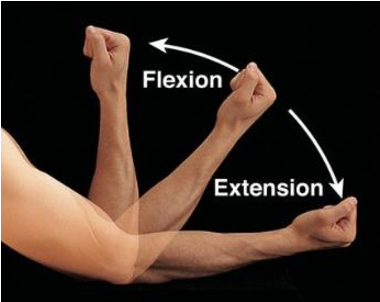
- Sit or stand with your arms outstretched in front of you, palms facing down.
- Slowly bend your elbow, bringing your hand to your shoulder, keeping your upper arm still.
- Hold the stretch for a few seconds and then extend the elbow back to the starting position.
- Repeat it 10 times.
Pronation and supination:
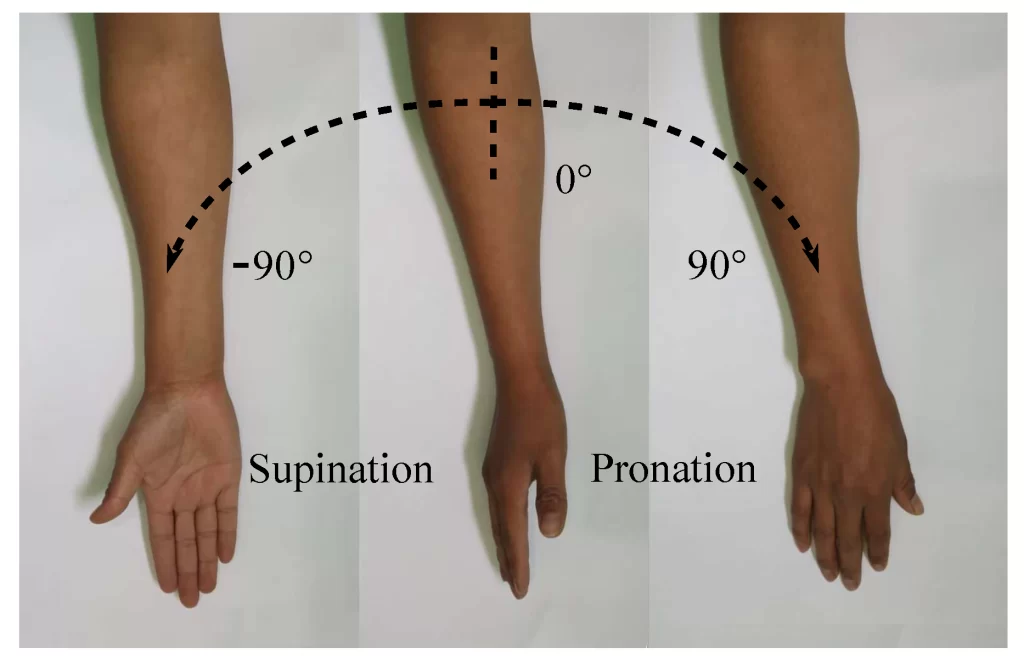
- Sit or stand, stretch your arms forward, palm up.
- Slowly turn the forearm inward so that the palm is facing down (pronation).
- Hold the stretch for a few seconds, then gradually rotate the forearm outward so that the palm is facing up (supination).
- Repeat it 10 times.
Elbows circles;
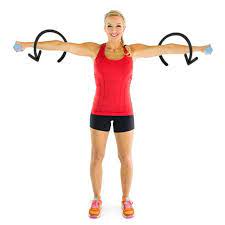
- Stand or sit, arm relaxed at the side, elbow slightly bent.
- Gently rotate the forearm in a circular motion, keeping the upper arm still.
- Begin with tiny circles and slowly increase the size of the circles.
- After a some repetitions, reverse the movement of the circles.
- Repeat it 10 times.
Wrist extension and flexion:

- Sit or stand with your arms outstretched in front of you, palms facing down.
- Bend the wrist back and bring the hand to the forearm (wrist extension).
- Hold the stretch for a few seconds, then slowly bend forward at the wrist, bringing your hand to the palm (wrist flexion).
- Repeat as many times as you want.
- It is important to perform these exercises in a pain-free range of motion.
- Start with gentle movements and gradually increase the area and intensity according to tolerance.
If you experience pain or discomfort during these exercises, it is recommended to consult a health professional or physical therapist. Remember to warm up the muscles before performing the range of motion exercises and perform them in a controlled manner. If you have special limitations due to your condition, contact a doctor or a qualified physiotherapist for exercises adapted to your needs.
Strengthening exercises:
Strengthening the elbow muscles can help provide support and stability, reducing stress on the affected area. A physical therapist will design exercises that target specific muscles, such as the biceps, triceps, and forearm muscles. Strengthening exercises can include resistance bands, weights, or bodyweight exercises.
Elbow strengthening exercises can help improve the stability, function and overall strength of the muscles surrounding the joint. Here are some effective exercises to strengthen elbows:
Bicep curls:
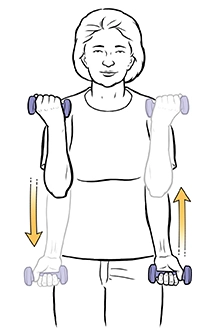
- Hold a dumbbell or resistance band, palms facing forward.
- Keeping the upper arm still, slowly bend the elbow by bending the weight or extending the band towards the shoulder.
- Hold the contraction for a second, then gradually lower the weight or release the tension on the band.
- Repeat as many times as you want.
- Begin with a weight or resistance level that challenges a person but allows for proper form.
Triceps extensions:
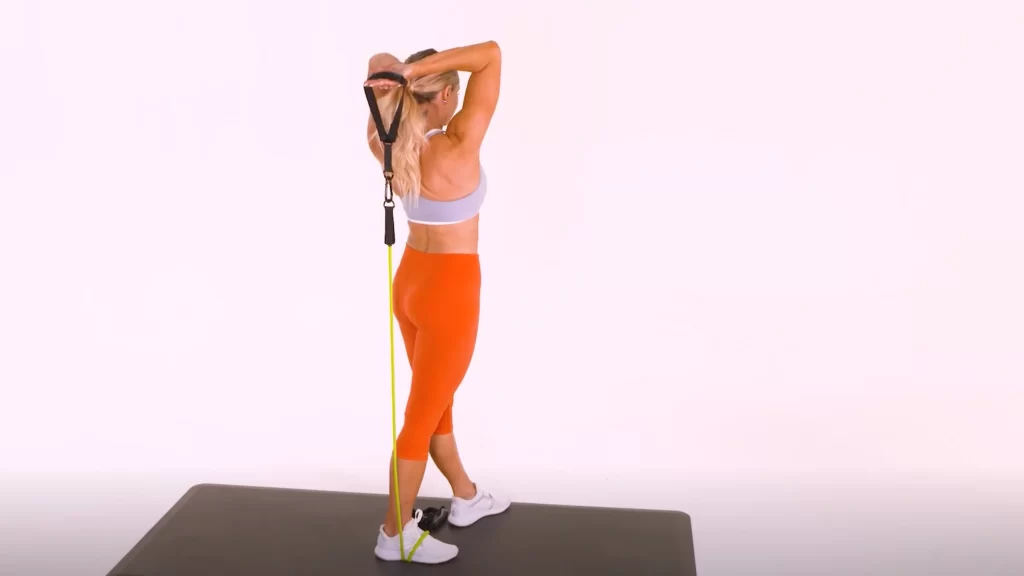
- Hold a stop in your hand, palm down.
- Extend your arm fully above your head, keeping your upper arm still.
- Slowly bend your elbows, lowering the weight behind your head or to your shoulders.
- Hold the contraction for a second and then extend your arms back to the starting position.
- Repeat as many times as you want.
- Adjust the weight as needed.
Push-ups:
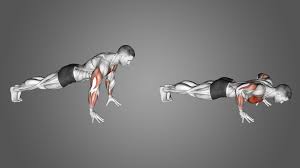
- Begin in a plank position with the hands slightly shoulder-width apart.
- Lower your body to the ground by bending your elbows, keeping them close to your sides.
- Returning to the beginning posture, press your arms.
- Repeat as many times as you want.
- Vary the intensity by doing push-ups on your knees or against the wall as needed.
Wrist Curls:
- Sit in a chair with your arm resting on your thigh, palm up.
- Hold a halter or a weighted object. Your weight should now be on your forearm as you slowly bend your wrist upward.
- Hold the contraction for a second and then gradually lower the weight back down.
- Repeat as many times as you want.
- Adjust the weight as needed.
Reverse Wrist Curls:

- Sit in a chair with the arm resting on the thigh, palm down.
- Hold a halter or a weighted object.
- Slowly bend your wrist down, bringing your weight to the floor.
- Hold the contraction for a second and then gradually lift the weight back up.
- Repeat as many times as you want.
- Adjust the weight as needed.
- It’s important to start with a weight or resistance level that allows you to maintain proper form while still challenging your muscles.
- Do these exercises with controlled movements and focus on muscle contractions.
- If you experience pain or discomfort, reduce your weight or resistance, or seek advice from a doctor or qualified physiotherapist.
- Be sure to warm up before performing strengthening exercises and allow for adequate rest and recovery between exercises.
- Gradually increase the weight, resistance or intensity over time as your strength improves.
Stretching and flexibility exercises:
Stretching exercises can help improve flexibility and prevent muscle strains. A physical therapist will guide you through stretches that target the muscles and tendons around the elbow joint. Elbow stretching exercises can help improve flexibility, relieve muscle tension, and maintain or restore range of motion. Here are some effective elbow stretching exercises:
Wrist flexor stretch:
- Extend the arms in front of you, palm up.
- With the opposite hand, slowly bend the wrist, pointing the fingers downward.
- A person should experience a stretch on the underside of the forearm.
- Hold the stretch for 20-30 seconds and then release.
- Repeat with the other hand.
Wrist Stretch:

- Extend the arms in front of you, palm down.
- With the other hand, gently bend the wrist, pointing the fingers upwards.
- You should feel a stretch at the top of your forearm.
- Hold the stretch for 20-30 seconds and then release. Repeat with the other hand.
Triceps stretch:
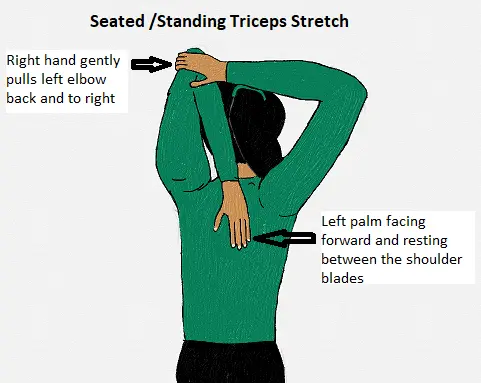
- Extend one arm above the head, elbow up.
- Bend the elbow and reach the hand toward the opposite shoulder blade.
- With the other hand, gently push the elbow back to deepen the stretch.
- A person should experience a stretch in the back of the upper arm.
- Hold the stretch for 20-30 seconds and then release.
- Repeat with the other hand.
Biceps stretch:
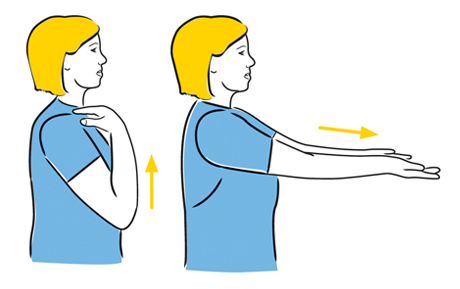
- Extend the arm in front of you, palm up.
- Bend the elbow and turn the palm away from you.
- With the other hand, slowly pull the fingers back and down to deepen the stretch.
- A person should experience a stretch in the front of the upper arm.
- Hold the stretch for 20-30 seconds and then release.
- Repeat with the other hand.
Cross Body Arm Stretch:
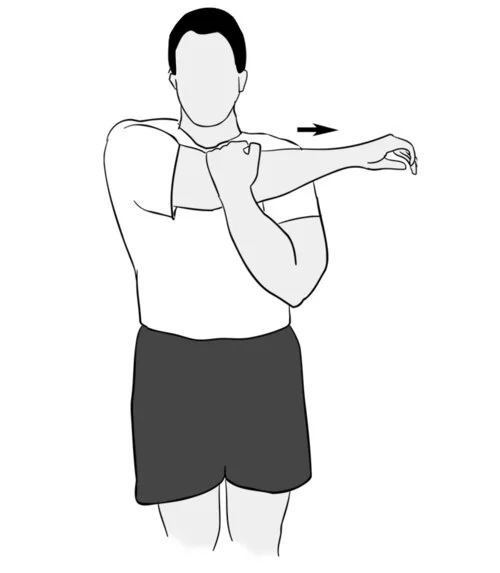
- Extend one arm straight across your chest.
- Use your other hand to gently pull the outstretched arm closer to the body.
- You should feel a stretch in the back of your shoulder and upper arm.
- Hold the stretch for 20-30 seconds and then release.
- Repeat with the other hand.
- Remember to perform these stretches slowly and with control.
- Avoid jerking or jerking movements as they can cause injury.
- Keep each stretch in a place of light tension, never in a place of pain.
- If you experience pain or discomfort, reduce the intensity or duration of the stretch or seek advice from a doctor or qualified physical therapist.
- Do these stretch regularly, preferably after a warm-up or physical activity when your muscles are already warmed up.
- Incorporating stretching exercises into your routine can help maintain or improve flexibility and promote overall elbow health.
Manual therapy:
- Manual therapy techniques such as soft tissue mobilization, joint mobilization or myofascial release can be used by a physical therapist to relieve pain, reduce muscle tension and improve joint function.
- These hands-on methods can help improve circulation, promote healing, and restore normal tissue mobility.
Modalities
Physiotherapy methods can be used to relieve pain and inflammation. These may include ultrasound therapy, electrical stimulation, or hot and cold therapy. A physical therapist will determine the appropriate method based on your specific needs and response to treatment.
Physiotherapy methods can be used as an additional treatment to relieve pain, reduce inflammation and promote the healing of elbow spurs. Here are some commonly used physical therapy methods for elbow spurs:
Ultrasound therapy:
- Ultrasound involves the use of high-frequency sound waves that penetrate deep into the tissue.
- It can help increase blood flow, reduce pain, and promote tissue healing.
- Ultrasound therapy is often used in conjunction with a topical gel that is applied directly to the affected area by a physical therapist.
Electrical stimulation:
- Electrical stimulation involves the use of electrical currents to stimulate nerves and muscles.
- It can help reduce pain, improve muscle strength, and improve circulation.
- Different types of electrical stimulation, such as transcutaneous electrical nerve stimulation (TENS) or neuromuscular electrical stimulation (NMES), can be used to treat different aspects of the condition.
Cold therapy (cryotherapy):
- Ice or cold packs are used in cold therapy.
- It can help reduce pain, swelling, and inflammation by constricting blood vessels and numbing the area.
- Cold therapy is usually used during the acute phase of an injury or when symptoms worsen.
Heat therapy:
- Heat therapy involves applying heat to the affected area, usually with hot packs or hot towels.
- Heat can improve circulation, relax muscles and relieve stiffness.
- Heat therapy is often used before stretching or exercise to improve muscle flexibility and joint mobility.
Iontophoresis:
- Iontophoresis is a technique that uses a mild electric current to facilitate drug delivery through the skin.
- It can be used to deliver anti-inflammatory drugs or other medications directly to the affected area, providing local pain relief and reducing inflammation.
Laser therapy:
- Low-level laser therapy (LLLT) uses specific wavelengths of light to promote tissue healing, reduce pain, and reduce inflammation.
- It is a non-invasive method that can penetrate deep into tissues, stimulating cellular processes and strengthening the body’s natural healing mechanisms.
- The choice of procedures depends on the specific needs and reactions of each person.
- A physical therapist will evaluate your condition and determine the appropriate combination for your treatment plan.
- It is important to note that the methods are usually used in conjunction with other physical therapy procedures, such as exercises, manual therapy, and patient education.
- The overall treatment plan must be tailored to your condition and may include a combination of different approaches to achieve the best possible result.
Ergonomics and activity modification:
- A physical therapist can provide guidance on proper ergonomics and body mechanics to reduce stress on the elbow joint during daily activities or specific tasks.
- They may recommend changes to your activities or work environment to reduce joint stress and prevent joint damage.
Education and Home Exercise Program:
- A physical therapist educates you about your condition, proper joint care, and self-management strategies.
- They will provide you with a home exercise program tailored to your needs, allowing you to continue your rehabilitation outside of the clinic and maintain your progress.
- Elbow physiotherapy is usually provided over several sessions, with the frequency and duration of therapy depending on the individual and the severity of the condition.
- It is important to follow the prescribed exercises and make follow-up visits to monitor progress and make necessary changes in treatment.
FAQs
Initial elbow spurs can be treated with rest, anti-inflammatory medications, and a physical therapy program that focuses on stretching and muscle strengthening. If the stimuli persist, non-surgical interventions often do not allow the patient to return to pre-injury activity levels.
Patients may have difficulty reaching or in some cases feel pain at the end of the movement. The symptoms can interfere with the ability to work or play sports. Examination of the joint shows a slight loss of motion compared to the contralateral side (if normal).
Once bone tissue has grown, it will not go away or resorb. There is no way to remove a bone spur other than cutting it out, but this is generally not recommended unless the spur is critically compressing a nerve or spinal cord, causing weakness.
They may not even cause symptoms unless they start pressing on nerves or tendons. A bone spur can form in almost any joint of the body. They are more common with age or osteoarthritis. Some people may need surgery to remove the bones, but most people can survive with treatment that is easier to tolerate.
Vitamin K2 plays a vital role in joint health. When soft tissues or joints are damaged by injury or stress, the body responds with inflammation and healing. This process can lead to scar tissue building up and forming over several years, causing bone spurs and permanent damage.

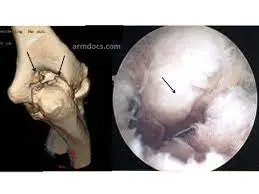
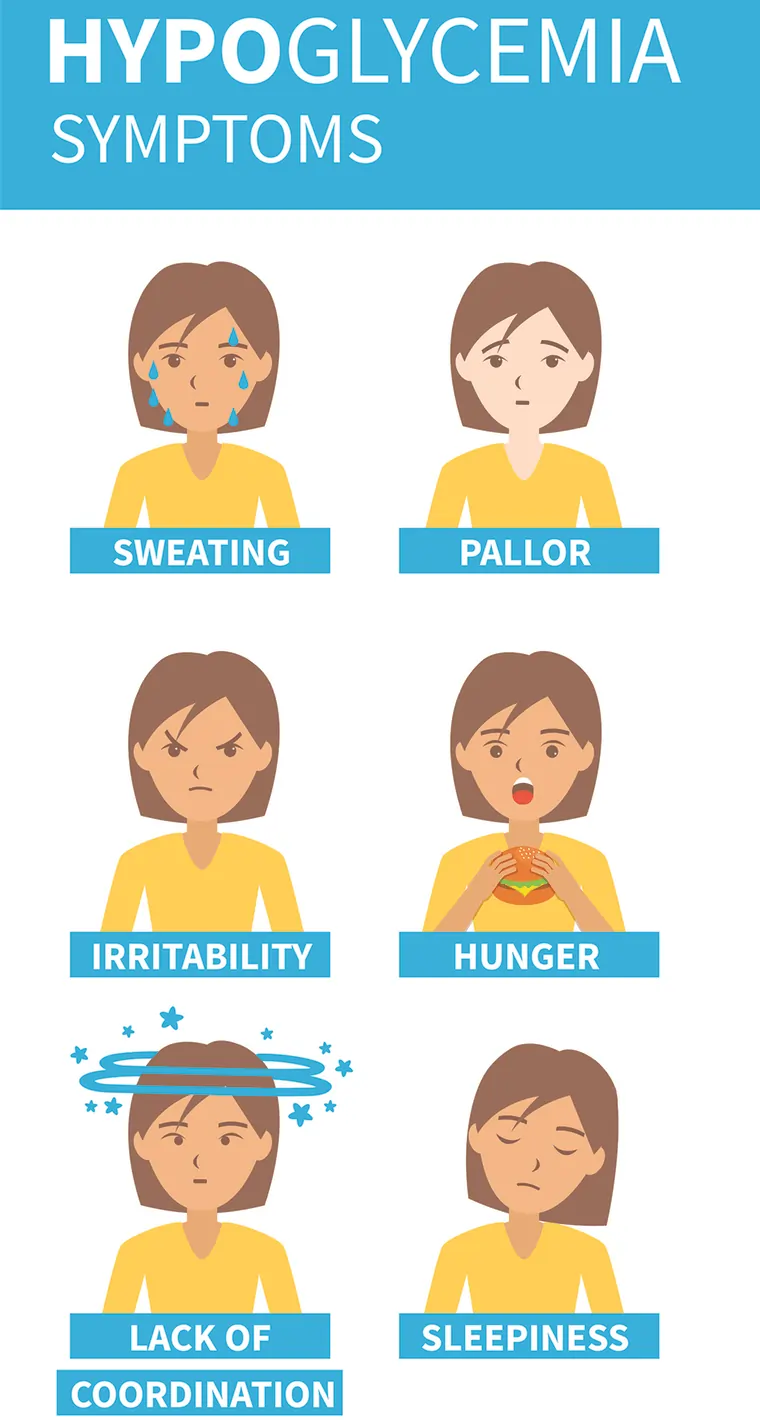
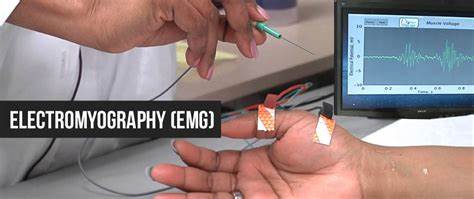
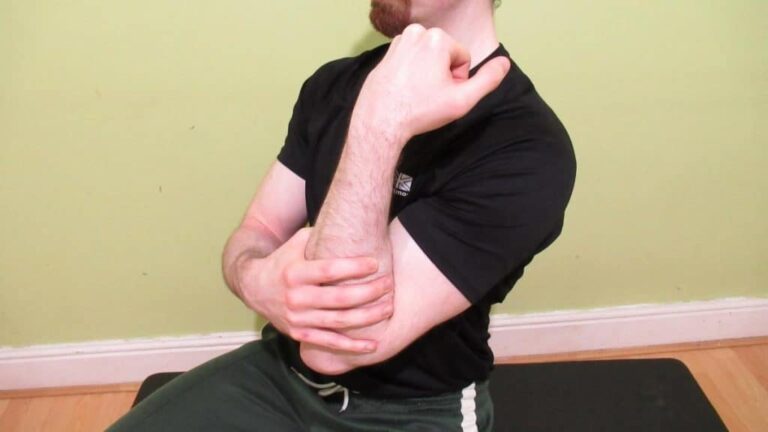
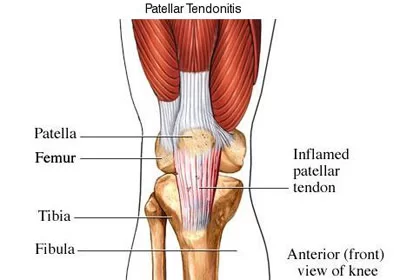
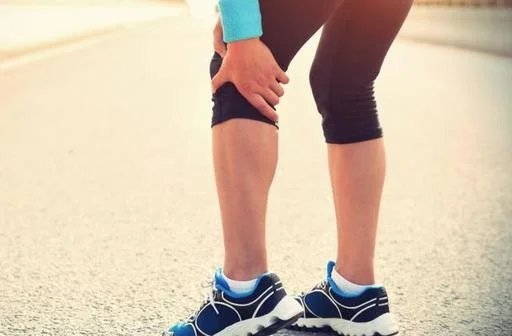
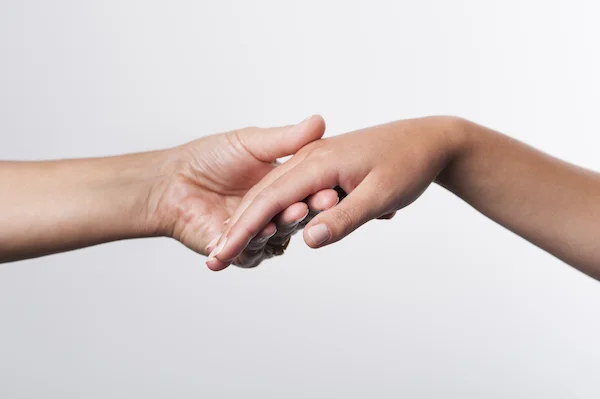
One Comment